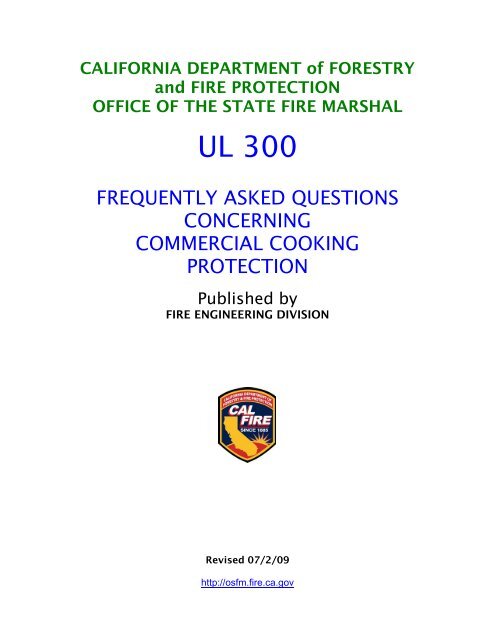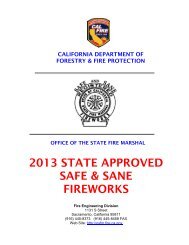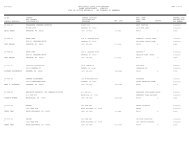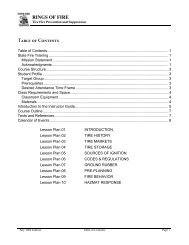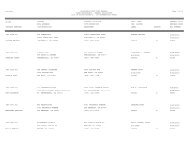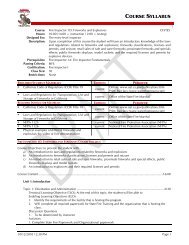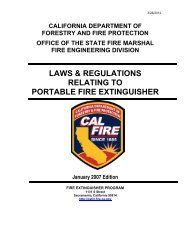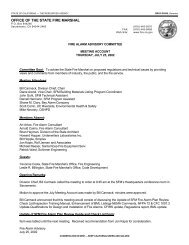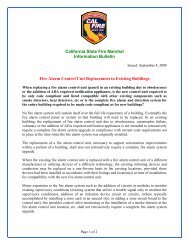UL 300 - Office of the State Fire Marshal
UL 300 - Office of the State Fire Marshal
UL 300 - Office of the State Fire Marshal
You also want an ePaper? Increase the reach of your titles
YUMPU automatically turns print PDFs into web optimized ePapers that Google loves.
CALIFORNIA DEPARTMENT <strong>of</strong> FORESTRY<br />
and FIRE PROTECTION<br />
OFFICE OF THE STATE FIRE MARSHAL<br />
<strong>UL</strong> <strong>300</strong><br />
FREQUENTLY ASKED QUESTIONS<br />
CONCERNING<br />
COMMERCIAL COOKING<br />
PROTECTION<br />
Published by<br />
FIRE ENGINEERING DIVISION<br />
Revised 07/2/09<br />
http://osfm.fire.ca.gov
Preface:<br />
This document addresses <strong>the</strong> frequently asked questions concerning <strong>the</strong> installation, inspection,<br />
testing and maintenance <strong>of</strong> commercial cooking fire suppression systems as addressed in<br />
California <strong>Fire</strong> Code (CFC) §904 Alternative Automatic <strong>Fire</strong>-Extinguishing Systems and <strong>the</strong><br />
California Mechanical Code (CMC) §513 <strong>Fire</strong>-Extinguishing Equipment.<br />
Also an Information Bulletin explaining <strong>the</strong> implementation <strong>of</strong> CFC §904.11 may be found on <strong>the</strong><br />
<strong>State</strong> <strong>Fire</strong> <strong>Marshal</strong>s’ website:<br />
http://osfm.fire.ca.gov/informationbulletin/pdf/2007/020707Prot<strong>of</strong>RestaurantCooking20Areas.pdf<br />
The <strong>Office</strong> <strong>of</strong> <strong>the</strong> <strong>State</strong> <strong>Fire</strong> <strong>Marshal</strong> amended CFC §904.11 to clarify <strong>the</strong> application <strong>of</strong><br />
Underwriters Laboratories Standard <strong>300</strong> (<strong>UL</strong> <strong>300</strong>). These regulations became effective January 1,<br />
2008.<br />
All automatic fire extinguishing systems used for <strong>the</strong> protection <strong>of</strong> commercial cooking operations<br />
that produce grease laden vapors shall comply with <strong>UL</strong> <strong>300</strong>. All existing dry and wet chemical fire<br />
extinguishing systems installed for <strong>the</strong> protection <strong>of</strong> those operations shall comply with <strong>the</strong> <strong>UL</strong> <strong>300</strong><br />
Standard no later than <strong>the</strong> second required servicing <strong>of</strong> <strong>the</strong> system after January 1, 2008.<br />
2 <strong>of</strong> 9
Question: Where can I find <strong>the</strong> regulations that require <strong>the</strong> installation <strong>of</strong> automatic fireextinguishing<br />
systems to protect commercial cooking equipment that produces grease laden<br />
vapor?<br />
Answer: CFC §904.11 and <strong>the</strong> CMC §513.2.2<br />
Question: Where can I find <strong>the</strong> law that requires automatic fire-extinguishing systems installed to<br />
protect commercial cooking equipment to be Inspected, Tested and Maintained?<br />
Answer: For <strong>the</strong> law (statute) see Health and Safety Code (H&S) §13195. You can view <strong>the</strong> law by<br />
visiting: http://leginfo.ca.gov/ and clicking on “California Law”, <strong>the</strong>n click on Health and Safety<br />
Code and type in <strong>the</strong> §13195.<br />
Question: When did <strong>the</strong> retroactive requirement for automatic fire-extinguishing systems that<br />
protect commercial cooking equipment which produces grease laden vapor meet <strong>the</strong> <strong>UL</strong> <strong>300</strong><br />
Standard?<br />
Answer: The CFC §904.11 and CMC §513.2.2 became effective January 1, 2008.<br />
Question: Can a company holding a <strong>State</strong> <strong>Fire</strong> <strong>Marshal</strong> “A” License Install a fire protection<br />
system?<br />
Answer: No . Pursuant to <strong>the</strong> Business and Pr<strong>of</strong>essions Code §7026.12, only a Contractors <strong>State</strong><br />
Licensing Board Licensed C-16 Contractor shall install a fire protection system.<br />
Business and Pr<strong>of</strong>essions Code §7026.12. The installation <strong>of</strong> a fire protection system,<br />
excluding an electrical alarm system, shall be performed only by a contractor holding a<br />
fire protection contractor classification as defined in <strong>the</strong> regulations <strong>of</strong> <strong>the</strong> board or by an<br />
owner-builder <strong>of</strong> an owner-occupied, single-family dwelling, if not more than two singlefamily<br />
dwellings on <strong>the</strong> same parcel are constructed within one year, plans are submitted<br />
to and approved by <strong>the</strong> city, county, or city and county authority, and <strong>the</strong> city, county, or<br />
city and county authority inspects and approves <strong>the</strong> installation.<br />
Question: I have one quote for $1200 and ano<strong>the</strong>r for $4500. Both quotes claim <strong>the</strong>ir work will<br />
bring my hood fire extinguishing system up to code. What steps should I take to ensure <strong>the</strong> work<br />
complies with <strong>UL</strong> <strong>300</strong>?<br />
Answer: Try to obtain at least 3 proposals from contractors properly licensed by <strong>the</strong> Contractor<br />
<strong>State</strong> Licensing Board (CSLB) as a C-16 to perform <strong>the</strong> work. Make sure that <strong>the</strong>y include permit<br />
fees, plans submittal and an acceptance test witnessed by <strong>the</strong> Authority Having Jurisdiction.<br />
3 <strong>of</strong> 9
Question: My vendor advises me that I currently have a dry chemical system that cannot be<br />
certified. What course <strong>of</strong> action should I take?<br />
Answer: You should work with your local fire department to ensure that <strong>the</strong> information your<br />
vendor provided is accurate. Try to obtain at least 3 proposals from contractors properly licensed<br />
by <strong>the</strong> Contractor <strong>State</strong> Licensing Board (CSLB) as a C-16 contractor to perform <strong>the</strong> work. Make<br />
sure that <strong>the</strong> proposal includes permit fees, plans submittal and an acceptance test witnessed by<br />
<strong>the</strong> Authority Having Jurisdiction. Please remember that dry chemical systems cannot be<br />
upgraded. The entire system must be replaced.<br />
Question: How long do I have to accomplish this work?<br />
Answer: The work should have been completed by December 31, 2008. While <strong>the</strong> code is very<br />
clear regarding this requirement, local authorities have <strong>the</strong> regulatory authority to evaluate your<br />
situation and apply <strong>the</strong> CFC as <strong>the</strong>y deem necessary. For fur<strong>the</strong>r information, please see our<br />
bulletin at: http://osfm.fire.ca.gov/informationbulletin/pdf/2008/ul<strong>300</strong>compliancedeadline.pdf<br />
Question: A school district is using <strong>the</strong>ir kitchens in <strong>the</strong> elementary schools to “warm” food only<br />
This is done with existing ovens. The only appliances are range tops and ovens. Do <strong>the</strong>y have to<br />
remove and replace <strong>the</strong> existing hood fire suppression system?<br />
Answer: Public schools kitchens, without deep-fat fryers, shall be upgraded to a <strong>UL</strong> <strong>300</strong> compliant<br />
system during state funded modernization projects that are under <strong>the</strong> jurisdiction <strong>of</strong> <strong>the</strong> Division <strong>of</strong><br />
<strong>the</strong> <strong>State</strong> Architect (DSA). For fur<strong>the</strong>r information, please see our bulletin at:<br />
http://osfm.fire.ca.gov/informationbulletin/pdf/2007/020707Prot<strong>of</strong>RestaurantCooking20Areas.pdf<br />
Question: What regulation requires upgrade to a <strong>UL</strong> <strong>300</strong> <strong>Fire</strong> Suppression System?<br />
Answer: The CFC §904.11.<br />
904.11 Commercial cooking systems. Commercial cooking equipment that produce<br />
grease laden vapors shall be provided with a Type I hood, in accordance with <strong>the</strong> CMC,<br />
and an automatic fire-extinguishing system that is listed and labeled for its intended use as<br />
follows:<br />
1. Wet-chemical extinguishing system, complying with <strong>UL</strong> <strong>300</strong>.<br />
2. Carbon dioxide extinguishing systems.<br />
3. Automatic fire sprinkler systems.<br />
All existing dry-chemical and wet-chemical extinguishing systems shall comply with <strong>UL</strong> <strong>300</strong><br />
no later than <strong>the</strong> second required servicing <strong>of</strong> <strong>the</strong> system following <strong>the</strong> effective date <strong>of</strong> this<br />
section.<br />
CMC § 513.2.2<br />
513.2.2 Commercial cooking systems. Commercial cooking equipment that produces<br />
grease laden vapors shall be provided with a Type I hood, in accordance with <strong>the</strong> CMC,<br />
4 <strong>of</strong> 9
and an automatic fire-extinguishing system that is listed and labeled for its intended use as<br />
follows:<br />
1. Wet-chemical extinguishing system (NFPA 17A, Standard for Wet Chemical<br />
Extinguishing Systems), complying with <strong>UL</strong> <strong>300</strong>),<br />
2. Carbon dioxide extinguishing systems (NFPA 12, Standard on Carbon Dioxide<br />
Extinguishing Systems),<br />
3. Automatic fire sprinkler systems (NFPA 13, Standard for <strong>the</strong> Installation <strong>of</strong> Sprinkler<br />
Systems).<br />
All existing dry-chemical and wet-chemical extinguishing systems shall comply with <strong>UL</strong><br />
<strong>300</strong>, no later than <strong>the</strong> second required servicing <strong>of</strong> <strong>the</strong> system following <strong>the</strong> effective date<br />
<strong>of</strong> this section.<br />
Question: How and when was <strong>the</strong> fire service community and <strong>the</strong> public notified?<br />
Answer: Throughout <strong>the</strong> adoption process <strong>the</strong> fire service community was updated through <strong>the</strong><br />
NorCal and SoCal <strong>Fire</strong> Prevention <strong>Office</strong>r meetings and through <strong>the</strong> public notice process <strong>of</strong> <strong>the</strong><br />
Building standards Commission. The <strong>Office</strong> <strong>of</strong> <strong>the</strong> <strong>State</strong> <strong>Fire</strong> <strong>Marshal</strong> posted <strong>the</strong> Automatic<br />
Extinguishing System Advisory Committee meeting minutes and proposed regulation on our<br />
website.<br />
The Insurance Industry, California Restaurant Association, California Hotel Motel Association,<br />
three Public School Associations, <strong>the</strong> <strong>Fire</strong> Protection Industry and <strong>the</strong> <strong>Fire</strong> Service all were<br />
represented during <strong>the</strong> regulation development process.<br />
Question: Are <strong>Fire</strong> Suppression System Tags required to be submitted to <strong>the</strong> <strong>Office</strong> <strong>of</strong> <strong>the</strong> <strong>State</strong><br />
<strong>Fire</strong> <strong>Marshal</strong> for approval?<br />
Answer: Yes, all tags shall be submitted to <strong>the</strong> <strong>Office</strong> <strong>of</strong> <strong>the</strong> <strong>State</strong> <strong>Fire</strong> <strong>Marshal</strong> for approval in<br />
accordance with California Code <strong>of</strong> Regulations, Title 19 §906, which states:<br />
General<br />
(a) Labels shall be used on water-based fire protection systems.<br />
(b) Tags shall be used on engineered and pre-engineered fixed extinguishing systems.<br />
(c) Labels and tags shall be white with black letters. They shall be five and one-fourth<br />
inches (5-1/4") in length, and two and five-eighth inches (2-5/8") in width with a one-fourth<br />
inch (1/4") tolerance for each dimension. One sample label and/or tag shall be submitted to<br />
<strong>the</strong> <strong>Office</strong> <strong>of</strong> <strong>the</strong> <strong>State</strong> <strong>Fire</strong> <strong>Marshal</strong> for approval.<br />
Question: Are local fire departments required to maintain a file <strong>of</strong> <strong>the</strong> testing documents that are<br />
sent to <strong>the</strong>m?<br />
Answer: No. It is not <strong>the</strong> intent <strong>of</strong> <strong>the</strong> <strong>Office</strong> <strong>of</strong> <strong>the</strong> <strong>State</strong> <strong>Fire</strong> <strong>Marshal</strong> to mandate <strong>the</strong> retention <strong>of</strong><br />
automatic extinguishing system maintenance records. It is <strong>the</strong> responsibility <strong>of</strong> <strong>the</strong> contractor,<br />
company, or licensee to provide a written report <strong>of</strong> <strong>the</strong> test and maintenance results to <strong>the</strong> building<br />
owner and <strong>the</strong> local fire authority having jurisdiction at <strong>the</strong> completion <strong>of</strong> <strong>the</strong> testing and<br />
maintenance. It is <strong>the</strong> responsibility <strong>of</strong> <strong>the</strong> building owner to retain <strong>the</strong> records.<br />
5 <strong>of</strong> 9
NFPA 17A § 7.2.6 The records shall be retained for <strong>the</strong> period between <strong>the</strong> semiannual<br />
maintenance inspections.<br />
CFC §904.11.6.4 Extinguishing system service. Automatic fire-extinguishing systems<br />
shall be serviced at least every 6 months and after activation <strong>of</strong> <strong>the</strong> system. Inspection<br />
shall be by qualified individuals, and a certificate <strong>of</strong> inspection shall be forwarded to <strong>the</strong> fire<br />
code <strong>of</strong>ficial upon completion.<br />
Question: Do fire suppression systems on “taco” trucks or o<strong>the</strong>r food vehicles need to be<br />
upgraded to a <strong>UL</strong><strong>300</strong> system?<br />
Answer: Yes. The Health and Safety Code §113789 defines “Food Facility” which includes<br />
Mobile food facilities. Health and Safety Code §114149.1 (a) states:<br />
Mechanical exhaust ventilation equipment shall be provided over all cooking<br />
equipment as required to effectively remove cooking odors, smoke, steam,<br />
grease heat, and vapors. All mechanical exhaust ventilation equipment shall be<br />
installed and maintained in accordance with <strong>the</strong> California Mechanical Code,<br />
except that for units subject to Part 2 (commencing with Section 18000) <strong>of</strong><br />
Division 13, an alternative code adopted pursuant to Section 18028 shall govern<br />
<strong>the</strong> construction standards.<br />
The California Mechanical Code §513.2.2 requires <strong>the</strong> upgrade to <strong>UL</strong> <strong>300</strong>.<br />
Question: Is <strong>the</strong>re a comprehensive document that explains what restaurants are required to do<br />
to comply with <strong>UL</strong> <strong>300</strong> requirements?<br />
Answer: No. The CFC §904.11 and <strong>the</strong> CMC §513.2.2 require <strong>the</strong> change. The National <strong>Fire</strong><br />
Protection Association (NFPA) Standard 17A as adopted in <strong>the</strong> CFC is <strong>the</strong> guideline for installation.<br />
Question: Does <strong>the</strong> electrical power supply under <strong>the</strong> hood need to be switched <strong>of</strong>f when <strong>the</strong> fire<br />
suppression system is activated?<br />
Answer: Yes, see 2007 CFC §904.11.2<br />
904.11.2 System interconnection. The actuation <strong>of</strong> <strong>the</strong> fire extinguishing<br />
system shall automatically shut down <strong>the</strong> fuel or electrical power supply to <strong>the</strong><br />
cooking equipment. The fuel and electrical supply reset shall be manual.<br />
Question: Is a gas shut <strong>of</strong>f valve that controls <strong>the</strong> cook appliances required to activate when <strong>the</strong><br />
fire suppression system activated?<br />
Answer: Yes. Please see <strong>the</strong> 2007 CFC §904.11.2<br />
6 <strong>of</strong> 9
904.11.2 System interconnection. The actuation <strong>of</strong> <strong>the</strong> fire extinguishing<br />
system shall automatically shut down <strong>the</strong> fuel or electrical power supply to <strong>the</strong><br />
cooking equipment. The fuel and electrical supply reset shall be manual.<br />
Question: A fire suppression system can only be installed by a contractor with a C-16 license.<br />
Are <strong>the</strong>y also required to be certified by <strong>the</strong> manufacturer <strong>of</strong> <strong>the</strong> systems <strong>the</strong>y install?<br />
Answer: No. For <strong>the</strong> installation requirements please refer to <strong>the</strong> California Business and<br />
Pr<strong>of</strong>ession Code §7026.12. However, CFC §901.2 and NFPA 17A allow <strong>the</strong> AHJ to require factory<br />
certification.<br />
B & P 7026.12 The installation <strong>of</strong> a fire protection system, excluding an electrical<br />
alarm system, shall be performed only by a contractor holding a fire protection<br />
contractor classification as defined in <strong>the</strong> regulations <strong>of</strong> <strong>the</strong> board or by an<br />
owner-builder <strong>of</strong> an owner-occupied, single-family dwelling, if not more than two<br />
single-family dwellings on <strong>the</strong> same parcel are constructed within one year,<br />
plans are submitted to and approved by <strong>the</strong> city, county, or city and county<br />
authority, and <strong>the</strong> city, county, or city and county authority inspects and<br />
approves <strong>the</strong> installation.<br />
CFC 901.2 Construction documents. The fire code <strong>of</strong>ficial shall have <strong>the</strong><br />
authority to require construction documents and calculations for all fire<br />
protection systems and to require permits be issued for <strong>the</strong> installation,<br />
rehabilitation or modification <strong>of</strong> any fire protection system. Construction<br />
documents for fire protection systems shall be submitted for review and approval<br />
prior to system installation.<br />
NFPA 17A § 6.2* Review and Certification. Design and installation <strong>of</strong> systems<br />
shall be performed only by persons properly trained and qualified to design and/<br />
or install <strong>the</strong> specific system being provided. The installer shall provide<br />
certification to <strong>the</strong> authority having jurisdiction that <strong>the</strong> installation is in complete<br />
agreement with <strong>the</strong> terms <strong>of</strong> <strong>the</strong> listing and <strong>the</strong> manufacturer’s instruction and/or<br />
approved design.<br />
NFPA 17A § A.6.2 It is recommended that system design and installation<br />
personnel be certified in accordance with <strong>the</strong> manufacturer’s requirements. It is<br />
standard industry practice to provide expiration dates on training certificates.<br />
Question: Does CFC §904.11 require an upgrade to existing non-compliant hoods<br />
when a <strong>UL</strong> <strong>300</strong> system is being installed?<br />
Answer: No. It is not <strong>the</strong> intent <strong>of</strong> <strong>the</strong> CFC §904.11 to require <strong>the</strong> replacement <strong>of</strong> a<br />
hood that was installed according to <strong>the</strong> applicable standard, inspected and approved by<br />
<strong>the</strong> AHJ at <strong>the</strong> time <strong>of</strong> installation.<br />
7 <strong>of</strong> 9
Question: Is <strong>the</strong> owner required to make appropriate changes to <strong>the</strong> existing hood to<br />
meet <strong>the</strong> current requirements for a Type 1 hood?<br />
Answer: No. It is not <strong>the</strong> intent <strong>of</strong> <strong>the</strong> CFC §904.11 to require <strong>the</strong> replacement <strong>of</strong> a<br />
hood that was installed according to <strong>the</strong> applicable standard, inspected and approved by<br />
<strong>the</strong> AHJ at <strong>the</strong> time <strong>of</strong> installation.<br />
Question: Who makes <strong>the</strong> determination that a hood upgrade is necessary?<br />
Answer: The Authority Having Jurisdiction.<br />
Question: Would <strong>the</strong> determination to require an upgrade to a hood be made during <strong>the</strong><br />
plan review process.<br />
Answer: No. This would require a field inspection.<br />
CFC 901.2.1 <strong>State</strong>ment <strong>of</strong> compliance. Before requesting final approval <strong>of</strong> <strong>the</strong><br />
installation, where required by <strong>the</strong> fire code <strong>of</strong>ficial, <strong>the</strong> installing contractor shall<br />
furnish a written statement to <strong>the</strong> fire code <strong>of</strong>ficial that <strong>the</strong> subject fire protection<br />
system has been installed in accordance with approved plans and has been<br />
tested in accordance with <strong>the</strong> manufacturer's specifications and <strong>the</strong> appropriate<br />
installation standard. Any deviations from <strong>the</strong> design standards shall be noted<br />
and copies <strong>of</strong> <strong>the</strong> approvals for such deviations shall be attached to <strong>the</strong> written<br />
statement<br />
Question: Where can I find <strong>the</strong> requirements for cleaning <strong>the</strong> hood system?<br />
Answer: The CFC §904.11.6.3, <strong>the</strong> CMC §514.3<br />
CFC 904.11.6.3 Cleaning. Hoods, grease-removal devices, fans, ducts<br />
and o<strong>the</strong>r appurtenances shall be cleaned at intervals necessary to<br />
prevent <strong>the</strong> accumulation <strong>of</strong> grease. Cleanings shall be recorded, and<br />
records shall state <strong>the</strong> extent, time and date <strong>of</strong> cleaning. Such records<br />
shall be maintained on <strong>the</strong> premisis.<br />
CMC 514.3 Cleaning.<br />
514.3.1 Hoods, grease removal devices, fans, ducts, and o<strong>the</strong>r<br />
appurtenances shall be cleaned to bare metal or <strong>the</strong> original factory<br />
coating at frequent intervals prior to surfaces becoming heavily<br />
contaminated with grease or oily sludge. After <strong>the</strong> exhaust system is<br />
cleaned, it shall not be coasted with powder or o<strong>the</strong>r substance. The<br />
entire exhaust system shall be inspected by a properly trained, qualified,<br />
and certified company or person(s) in accordance with Table 5-4.<br />
8 <strong>of</strong> 9
514.3.1.1 Upon inspection, if found to be contaminated with<br />
deposits from grease-laden vapors, <strong>the</strong> contaminated portions <strong>of</strong> <strong>the</strong><br />
exhaust system shall be cleaned by a properly trained, qualified, and<br />
certified company or person(s) acceptable to <strong>the</strong> Authority Having<br />
Jurisdiction in accordance with §514.3. [NFPA 96 11.4.1]<br />
Question: Does <strong>the</strong> Gaylord water wash system meet <strong>the</strong> <strong>UL</strong><strong>300</strong> Standard?<br />
Answer: No. A Gaylord water wash hood does not comply with <strong>the</strong> <strong>UL</strong> <strong>300</strong> Standard<br />
for plenum and duct protection.<br />
Question: If a Gaylord water wash system is being upgraded<br />
to meet <strong>the</strong> <strong>UL</strong><strong>300</strong> Standard, is it required to install nozzles in <strong>the</strong> plenum and duct?<br />
Answer: Yes. A <strong>UL</strong> <strong>300</strong> compliant plenum and duct system must be installed in <strong>the</strong><br />
water wash hood. This does not require <strong>the</strong> installer be a Gaylord CSA.<br />
However, when <strong>the</strong> contractor cuts access into <strong>the</strong> hood, which <strong>the</strong>y will need to do, <strong>the</strong>y<br />
must use an access panel listed for use in a grease duct.<br />
For more information, please access: info@gaylordusa.com<br />
9 <strong>of</strong> 9


